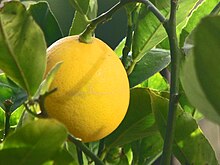| Meyer lemon | |
|---|---|

| |
| Scientific classification | |
| Kingdom: | Plantae |
| Clade: | Tracheophytes |
| Clade: | Angiosperms |
| Clade: | Eudicots |
| Clade: | Rosids |
| Order: | Sapindales |
| Family: | Rutaceae |
| Genus: | Citrus |
| Species: | C. × meyeri
|
| Binomial name | |
| Citrus × meyeri Yu.Tanaka
| |
Citrus × meyeri, the Meyer lemon (Chinese: 梅爾檸檬; pinyin: méiěr níngméng),[1] is a hybrid citrus fruit native to China. It is a cross between a citron and a mandarin/pomelo hybrid.[2]
Mature trees are around 6 to 10 ft (2 to 3 m) tall with dark green shiny leaves. The flowers are white with a purple base and are fragrant. The fruit is rounder than a true lemon, deep yellow with a slight orange tint when ripe, and has a sweeter, less acidic flavor. The lemons contain a highly acidic pH of between 2 and 3. This acidity level allows for these lemons to be used as antibacterial and antiseptic cleaners.
It was introduced to the United States in 1908 as S.P.I. #23028[3] by the agricultural explorer Frank Nicholas Meyer, an employee of the United States Department of Agriculture who collected a sample of the plant on a trip to China.[4] Though it is given his name, this variety was likely established thousands of years before he introduced it to America.[5]
The Meyer lemon is commonly grown in China in garden pots as an ornamental tree. It became popular as a food item in the United States after being rediscovered by chefs such as Alice Waters at Chez Panisse during the rise of California cuisine starting in the 1970s.[6][7] Popularity further climbed when Martha Stewart began featuring them in some of her recipes.[4]
- ^ "帶有柑橘甜味與花香,梅爾檸檬是什麼?跟一般檸檬差在哪?". NOM Magazine. 2017-09-12.
- ^ Curk, Franck; Ollitrault, Frédérique; Garcia-Lor, Andres; Luro, François; Navarro, Luis; Ollitrault, Patrick (2016). "Phylogenetic origin of limes and lemons revealed by cytoplasmic and nuclear markers". Annals of Botany. 11 (4): 565–583. doi:10.1093/aob/mcw005. PMC 4817432. PMID 26944784.
- ^ "Lemon". Hort.purdue.edu. Retrieved 2014-06-09.
- ^ a b O'Hara, Julie (18 February 2009). "The Meyer Lemon: More Than A Pretty Face". National Public Radio. Retrieved 2009-02-20.
- ^ "A Man, A Plan, A lemon, China". Taste Cooking. 5 March 2018.
- ^ Lowry, Patricia (February 12, 2009). "When life hands you Meyer lemons, life is sweet". Pittsburgh Post-Gazette. Pittsburgh.
- ^ "Domestic Programs". Slow Food USA. Archived from the original on 2012-11-24. Retrieved 2014-06-09.